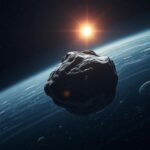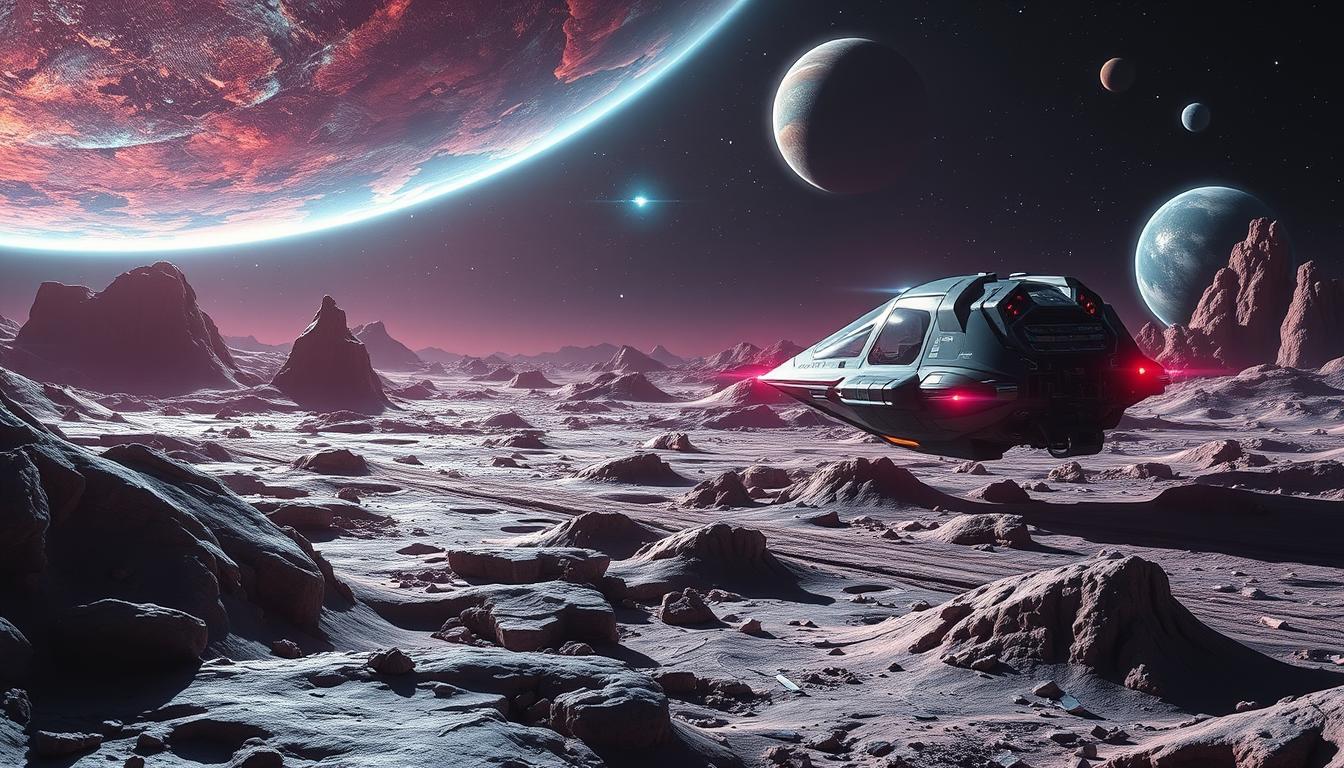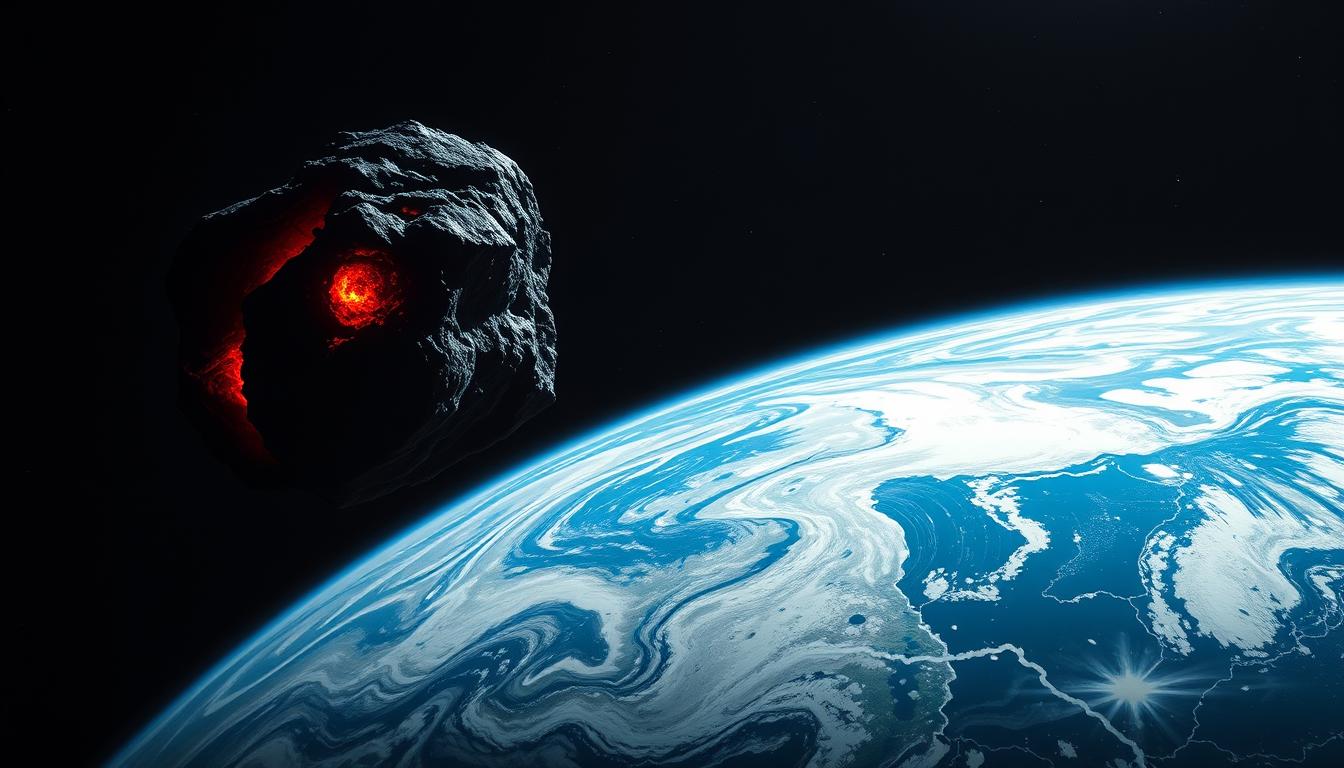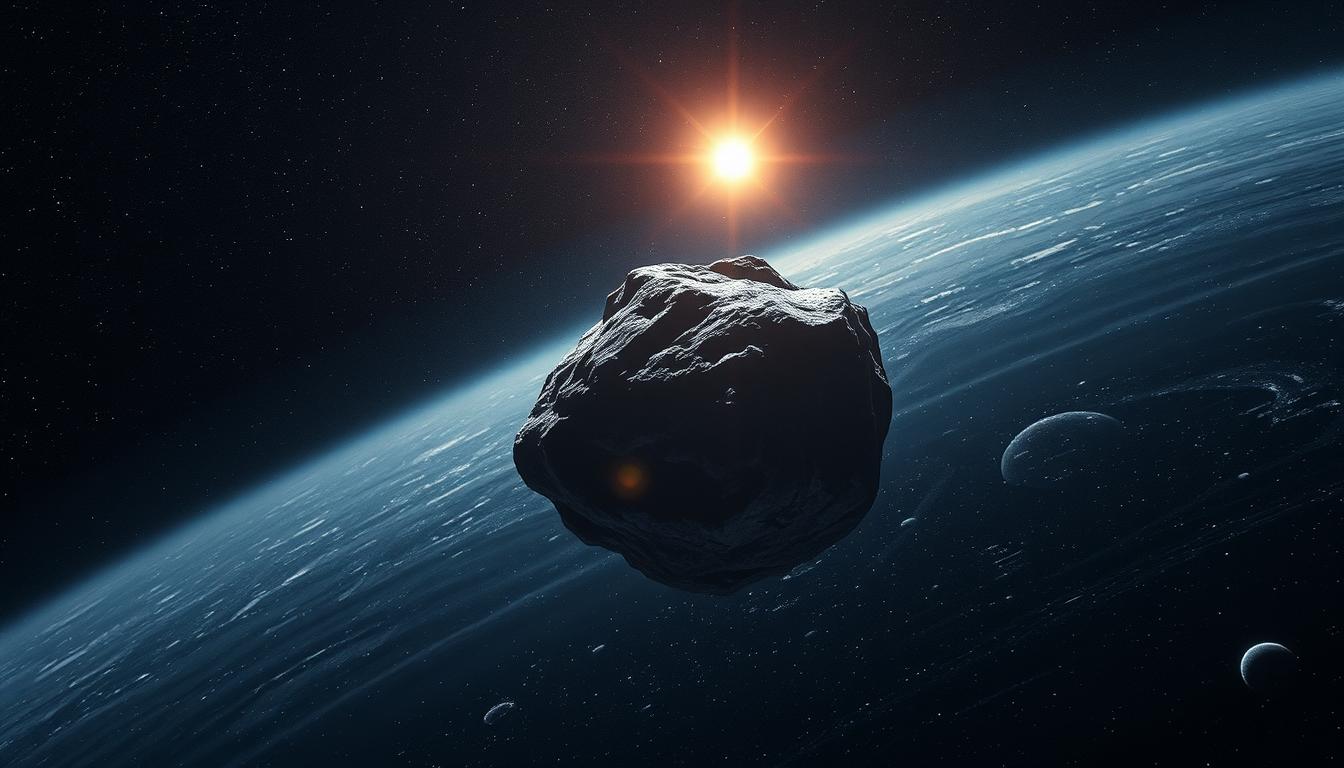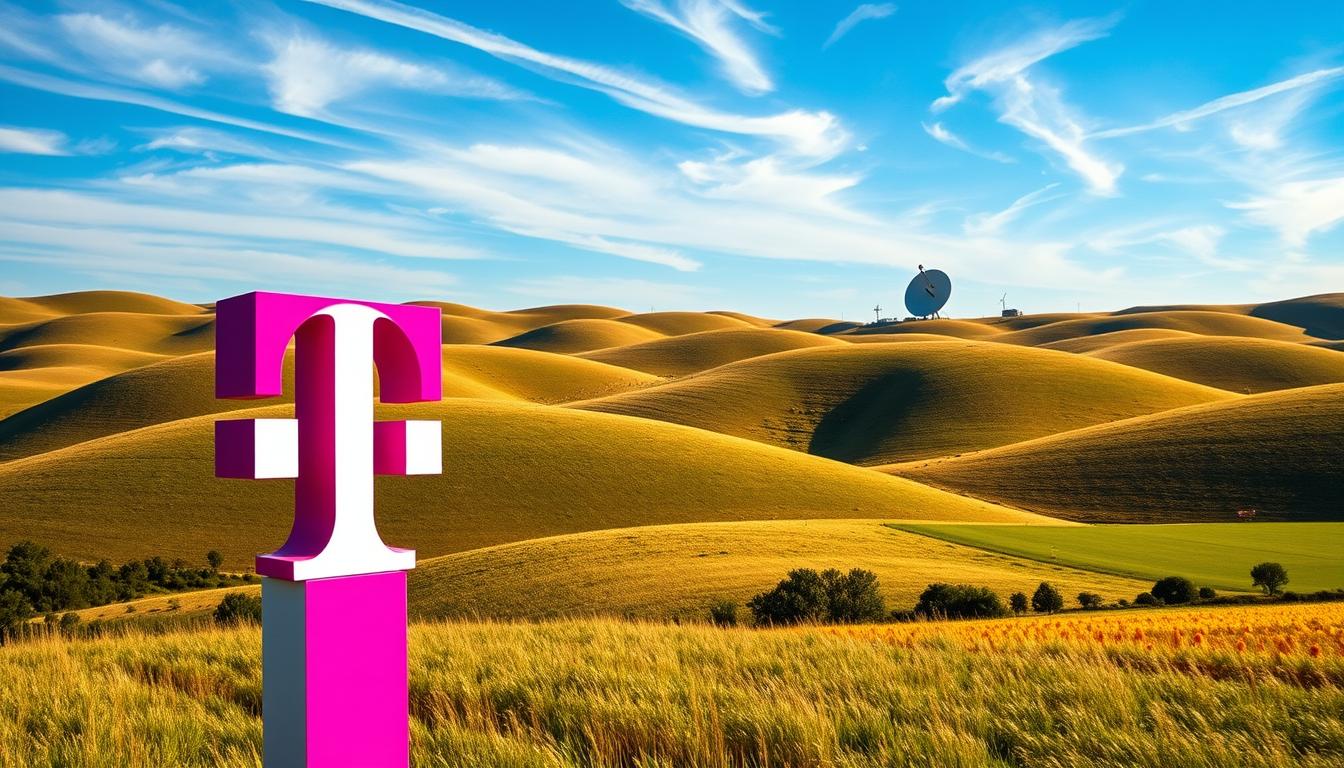When I first looked through a telescope, I was amazed by the moon planets. They seemed like tiny secrets from space. Our solar system is full of these natural satellites, each with its own story1.
Did you know most planets have their own moons? In fact, 6 out of 8 planets have natural satellites1. Mercury and Venus are the only ones without a moon1. Exploring the moons of Jupiter and Saturn gives us a peek into how planets work together.
Jupiter and Saturn have many moons, showing us how planets evolve. Jupiter has 79 moons, and Saturn has 821. These moons are more than just rocks; they tell us about the universe’s history.
Key Takeaways
- 8 planets exist in our solar system, with 6 hosting natural satellites
- Mercury and Venus are the only planets without moons
- Jupiter leads with 79 known moons, followed closely by Saturn with 82
- Moon planets reveal complex planetary system dynamics
- Natural satellites offer insights into cosmic formation processes
Understanding Natural Satellites in Our Solar System
When you gaze at the moon tonight, you might ponder the wonders of natural satellites in our solar system. These companions orbit planets, offering insights into space’s complexity2.
Definition of Natural Satellites
A natural satellite orbits a planet, dwarf planet, or asteroid. Unlike a bright star next to the moon, these moons are tied to their parent bodies by gravity2. Our solar system boasts diverse moon systems:
- Eight planets have natural satellites
- Seven dwarf planets also host moons
- Total known satellites: 288 in planetary systems2
Formation and Origins
Most natural satellites form in two ways. Some come from gas and dust discs around planets. Others are captured objects from space. Each moon has its own story3.
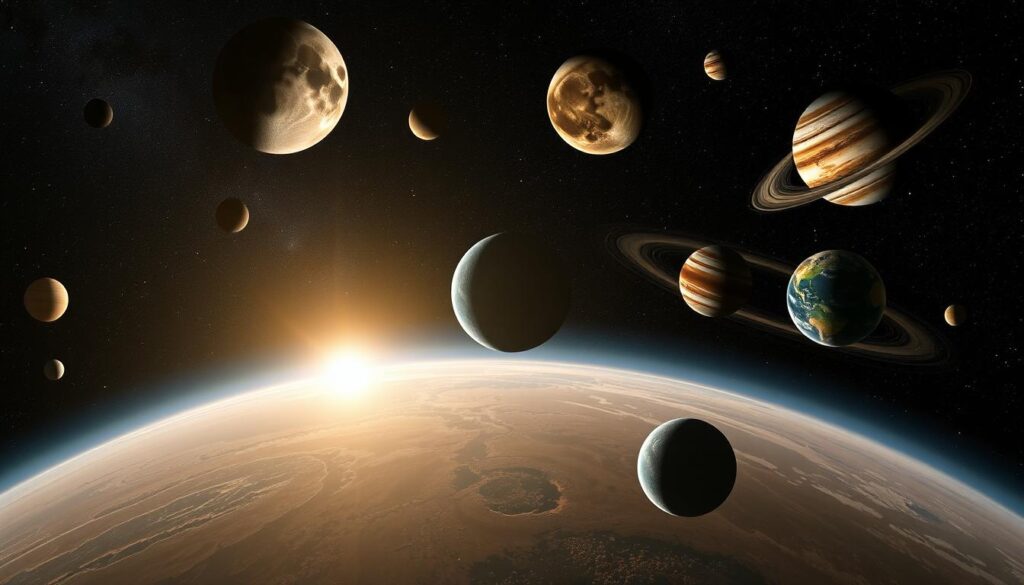
Role in Planetary Systems
Moons are vital in planetary systems. They stabilize planets, affect gravity, and offer research chances. Most moons are tidally locked, always facing their planet2.
“Moons are not just passive observers, but active participants in the cosmic dance of our solar system.” – Planetary Science Research
The variety of moons is incredible. From Earth’s one moon to Jupiter’s 95, these bodies captivate scientists and stargazers3.
Current Count of Known Moons in the Solar System
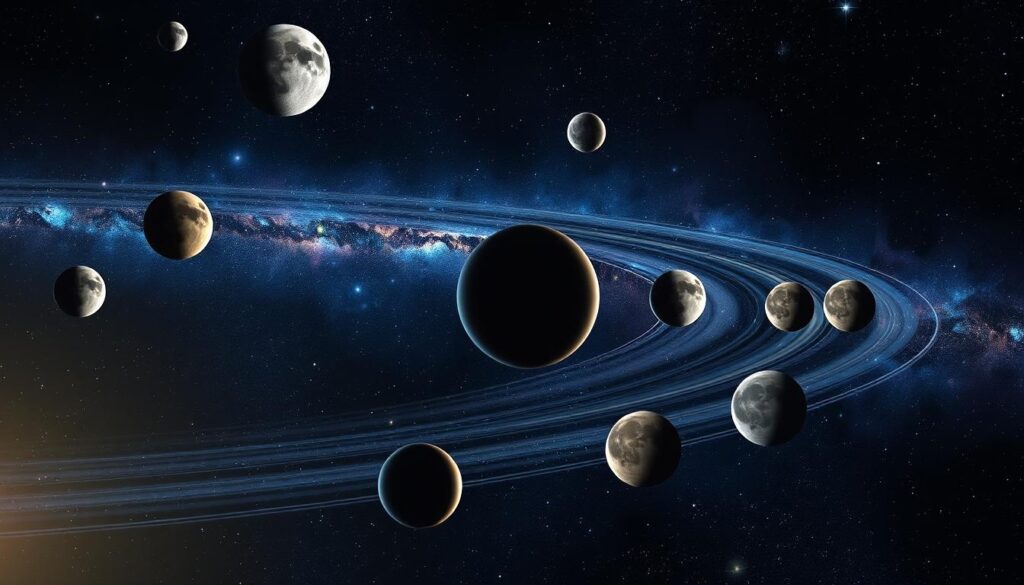
When you gaze up at the night sky, you might ponder the star next to the moon. Our solar system is filled with moons, each with its own tale of planetary growth4.
The lunar scene is truly awe-inspiring. Our solar system has 294 known moons, with some planets having many more4. If you’re curious about the bright star next to the moon tonight, you’ll find a variety of moon populations across planets5.
- Mercury and Venus: 0 moons4
- Earth: 1 primary moon5
- Mars: 2 moons (Phobos and Deimos)5
- Jupiter: An impressive 92 moons4
- Saturn: 145 known moons4
- Uranus: 27 moons4
- Neptune: 14 moons4
- Pluto: 5 moons4
The gas giants have the most moons, with Jupiter and Saturn at the top. Scientists keep finding new moons, deepening our knowledge of these celestial friends5.
Our solar system is a dynamic celestial playground, with each planet telling a unique story through its moons.
Some moons are so tiny they can only be spotted with advanced telescopes. This adds to the mystery and thrill of exploring space5.
Earth’s Moon: Our Closest Celestial Neighbor
When you gaze at the night sky, you might ask, “What’s next to the moon tonight?” Our lunar companion is a captivating celestial body that has fascinated humans for centuries. The moon and planet tonight create a mesmerizing visual spectacle that continues to intrigue astronomers and sky watchers alike.
The Moon is a remarkable celestial neighbor, playing a crucial role in Earth’s planetary system. A cosmic companion that’s both familiar and mysterious, it offers us incredible insights into planetary dynamics.
Physical Characteristics
Our Moon boasts impressive physical attributes that make it unique in our solar system. With a diameter of 3,476 km, it could fit approximately four Moons across Earth’s diameter6. Its surface tells a dramatic story of cosmic bombardment, featuring:
- Approximately 9,000 identified craters7
- Temperature ranges from -173°C to 127°C7
- About 61% of its surface covered by dark basaltic plains called maria7
Impact on Earth’s Stability
The Moon’s gravitational influence is profound. It accounts for approximately 50% of Earth’s tidal forces7, creating rhythmic ocean movements that support marine ecosystems. When you observe the planet near moon tonight, remember its stabilizing effect on our world.
Lunar Exploration History
One small step for man, one giant leap for mankind.
Lunar exploration has been a testament to human curiosity. NASA’s Apollo missions successfully landed on the Moon six times between 1969 and 19726. The Lunar Reconnaissance Orbiter has mapped the entire lunar surface with remarkable precision7.
Intriguingly, water was confirmed on the Moon in 2020, with significant deposits at the poles7, opening new possibilities for future space exploration.
Mars and Its Twin Moons: Phobos and Deimos
When you look up at the night sky, you might wonder about the star next to the moon. Mars has its own special sight with its two moons, Phobos and Deimos. These moons dance around Mars in a way that amazes scientists and space fans8.
Found in 1877, these moons are unlike any others in our solar system. Phobos, the bigger one, is very close to Mars, just 3,700 miles away9. It goes around Mars in 8 hours, making three orbits in one Martian day9.
- Phobos diameter: 22.2 km8
- Deimos diameter: 12.6 km8
- Unique orbital characteristics make them distinct from other moons
The bright star next to the moon tonight might seem less exciting than Phobos’ story. It’s being pulled apart by Mars’ gravity. Phobos is moving closer to Mars at 6 feet every century9. In about 50 million years, it will either hit Mars or become a ring9.
Mars’ moons are thought to be captured asteroids, made of carbon-rich rock and ice9.
What’s really cool about Phobos is how light you’d weigh there. A 150-pound person would weigh only 2 ounces9. The biggest crater, Stickney, is 6 miles wide and covers almost half of Phobos9.
Jupiter’s Moon Planets: A Complex System of Satellites
When you gaze at the night sky, you might wonder if there’s a planet next to the moon. Jupiter, with its amazing collection of moons, is a standout. This gas giant’s lunar system is a wonder that captures the hearts of astronomers and space fans10.
Jupiter has an incredible 95 officially recognized moons. This makes its planetary system as complex as many star systems10. The four biggest moons, known as the Galilean moons, have a fascinating story:
- Io: The most volcanically active world in our solar system11
- Europa: A potential habitat with a hidden subsurface ocean11
- Ganymede: The largest moon in the solar system with its own magnetic field11
- Callisto: A heavily cratered ancient planetary body
Recent Lunar Discoveries
Space missions keep revealing new things about Jupiter’s moon system. NASA’s Juno mission and the European Space Agency’s upcoming explorations are helping us learn more about these amazing bodies11.
Unique Planetary Features
Each of Jupiter’s moons has its own special traits. From Io’s constant volcanic activity to Europa’s chance of hosting alien life, these moons are much more than just rocks11.
The diversity of Jupiter’s moons represents one of the most fascinating planetary systems in our solar neighborhood.
If you’re into planetary dynamics, Jupiter’s moon system is a great place to start. Next time you’re looking up and wondering about planets by the moon, think about the amazing variety around Jupiter10.
Saturn’s Magnificent Moon Collection
Saturn is a true marvel in our solar system. It has an incredible collection of natural satellites that amaze scientists and space fans12. With at least 124 known moons, Saturn’s lunar landscape is both diverse and complex12.
Let’s explore some of the most remarkable moons in Saturn’s celestial family:
- Titan: The crown jewel of Saturn’s moons, Titan is larger than Mercury and hosts fascinating features12:
- Contains complex organic molecules
- Surface pressure 1.5 times that of Earth
- Only moon with liquid surfaces outside Earth
- Enceladus: A small moon with extraordinary potential13:
- Diameter of 500 kilometers
- Water jets spraying organic materials
- Potential global liquid water ocean
When searching for a bright star near the moon tonight, consider Saturn’s unique ring system. These spectacular rings span approximately 27 Earths wide and are composed of water ice chunks ranging from dust specks to mountain-sized objects12.
“Saturn’s moons represent some of the most intriguing worlds in our solar system, each with its own mysterious characteristics.” – NASA Planetary Science Division
The Cassini mission revealed incredible insights into these fascinating moons. It documented complex interactions and unique geological features that continue to challenge our understanding of planetary systems14.
Uranus: Literary-Named Natural Satellites
When you look at the star next to the moon tonight, imagine the unique world of Uranus’s moons. These celestial bodies carry a remarkable literary legacy. Most are named after characters from Shakespeare and Pope’s works15.
Uranus boasts 28 known moons, creating a fascinating planetary system. It captivates astronomers and space enthusiasts16. Their classification reveals an intriguing structure:
- 13 inner moons
- 5 major moons
- 10 irregular moons
Major Moons of Uranus
The five primary moons – Titania, Oberon, Ariel, Umbriel, and Miranda – each tell a unique story. Titania, the largest, measures 1,578 km in diameter. It is the eighth-largest moon in our Solar System15.
Orbital Characteristics
The planet next to the moon tonight might not be as uniquely positioned as Uranus. Its moons orbit in a nearly coplanar arrangement. The planet’s axis is tilted at an extraordinary 97.77 degrees15.
Surface Features
These moons exhibit fascinating characteristics. Miranda, for instance, features fault canyons up to 12 times deeper than the Grand Canyon. Umbriel stands out as the darkest and most cratered moon16.
Uranus’s moons represent a testament to the diversity and wonder of our Solar System’s celestial bodies.
Neptune’s Mysterious Moon Family
When you look up at the night sky, you might ask, “What planet is next to the moon tonight?” While Venus shines brightly, Neptune has a fascinating group of moons that capture astronomers’ attention17. Neptune has a total of 14 known moons, thanks to an amazing spacecraft mission17.
Triton is the star of Neptune’s moon system. It’s almost as big as Earth’s Moon and is thought to have come from the Kuiper Belt18. It has some amazing features:
- Active nitrogen frost volcanoes17
- A retrograde orbit, suggesting it has an unusual origin19
- It’s slightly more massive than Pluto18
Hippocamp is another interesting moon of Neptune. It’s just 20 miles wide and is a result of cosmic collisions19. Its small size is a contrast to bigger moons like Proteus, showing the variety in Neptune’s moon system19.
Neptune’s moons remind us that our solar system is a dynamic, ever-changing environment of celestial wonders.
Scientists are still learning about these distant moons. Each discovery helps us understand more about how planets formed and evolved18.
Hidden Oceans: Subsurface Water on Planetary Moons
When you look up at the night sky, you might wonder what planet is above the moon. But there’s a hidden world of oceans beneath the icy surfaces of distant moons. The venus saturn moon alignment might catch your eye, but the real thrill is the chance of finding life in these secret waters20.
Europa’s Ocean World
Jupiter’s moon Europa has a big secret. Scientists found a huge ocean under its icy layer, with more water than all Earth’s oceans20. This ocean stays liquid because of Jupiter’s tidal forces, making it a possible home for alien life21.
- Estimated ocean depth: Potentially hundreds of miles deep
- Temperature maintained by tidal forces
- Possible hydrothermal activity supporting potential life forms
Enceladus Water Systems
Saturn’s moon Enceladus is another water world. It has a global ocean under its icy shell, and it shoots water plumes into space. This shows how active its subsurface environment is20.
“The presence of liquid water suggests the potential for life beyond Earth” – Planetary Science Research Team
Potential for Life
These hidden oceans change how we think about life in our solar system. Scientists are really excited about the chemicals and energy sources that could support life in these harsh places21.
- Liquid water provides essential conditions for life
- Energy sources from tidal heating
- Potential chemical interactions supporting biological processes
As we get better at exploring, these underwater worlds keep pushing our limits of what we think is possible for life20.
Discovery and Classification of New Moons
Astronomers are always finding new secrets about moons in our solar system. When you gaze at the night sky, you might wonder what star is next to the moon or which planet is near it. You might not know about the amazing discoveries happening in space22.
Finding new moons is a complex task that uses advanced technology and careful checks. Modern telescopes and space missions have found many moons orbiting planets. For example, Jupiter now has 95 known moons, and Saturn has 82 confirmed satellites23.
“Each new moon discovery expands our understanding of planetary systems.” – Astronomical Research Team
The International Astronomical Union (IAU) manages how we classify moons. New moons get temporary numbers before they get official names22.
- Telescopes watch for potential moon candidates
- Many confirmations are needed for official status
- Names often come from myths
It’s interesting that the planet next to the moon tonight might have moons we haven’t found yet. Scientists think there could be thousands more moons in our solar system, especially around big planets23.
The search for new moons keeps challenging our views of the universe. It shows us how complex and dynamic the cosmos is22.
The Role of Moons in Planetary Ring Systems
When you look up at the night sky, you might wonder about the bright star next to the moon. You might not know about the amazing dance of celestial bodies around planets like Saturn. Planetary rings are incredible structures kept in place by special moons called shepherd moons24.
Shepherd moons are key to ring systems. They help create and keep rings in place with their gravity. For example, Saturn’s F ring is kept narrow by two small moons, Pandora and Prometheus24.
Ring Formation Mechanisms
Ring systems are complex places where moons and ring particles interact. Here are some important facts:
- Saturn’s rings stretch from 7,000 km to 80,000 km above the planet’s equator24
- There are about 3 x 10^16 ring particles24
- The space between ring particles is about 12 meters24
Gravitational Interactions
When you look for the bright star next to the moon tonight, think about moons and their gravity. Small moons can make gaps, waves, and detailed structures in rings. The Keeler Gap, for instance, is about 30 km wide and shows how moons shape rings24.
These cosmic sculptors continuously reshape and maintain the delicate structures surrounding planetary bodies.
Learning about these interactions helps scientists understand planetary systems better. It also helps them see how these systems change over time25.
Future Exploration of Moon Planets
Space exploration is on the verge of a new era. NASA and other space agencies are gearing up for deep dives into moon planets. They will use the latest technology26.
Future moon missions will explore different celestial bodies. Here are some exciting missions to look out for:
- Europa Clipper mission to investigate Jupiter’s moon27
- Dragonfly mission exploring Titan’s mysterious landscape28
- Lunar Trailblazer mission studying lunar water distribution28
Scientists are working on new tech to find out if there’s a planet next to the moon tonight. They’re using small satellites and robotic missions for this27.
“Space exploration is humanity’s greatest adventure of discovery” – NASA Administrator
New tech like light sail spacecraft and reusable launch vehicles are changing how we explore. Missions up to 2030 will give us new insights into our solar system’s neighbors2627.
The future of moon exploration is promising. International teamwork is pushing the boundaries of science and tech.
Conclusion
As you look up at the night sky, you might wonder about a bright star near the moon. You’ve explored the amazing world of moons. Moons show us a complex and fascinating universe that challenges our views of planets29.
Moons range from huge to tiny, each with its own story. They are more than just interesting sights in the sky30. They help us understand how planets form and what life might be like elsewhere.
Looking at the moon, you might see a star nearby. Remember, these stars and moons hold secrets of our universe29. They tell us about the birth of planets and the possibility of life beyond Earth.
The study of the moon is very exciting and will keep getting better. Scientists are always learning more about these worlds. They show us how the universe evolved and changed over time30.
As technology gets better, we’ll learn even more about moons. Each new discovery brings us closer to understanding our universe. It shows us how amazing and complex the world around us really is29.



